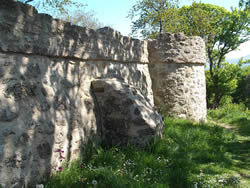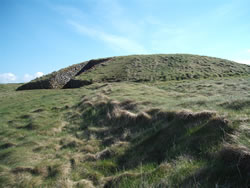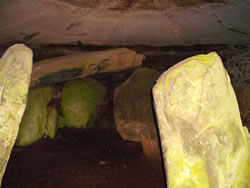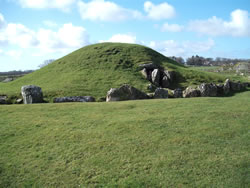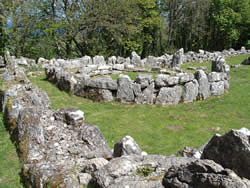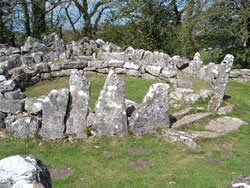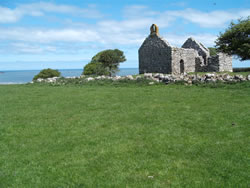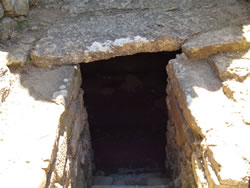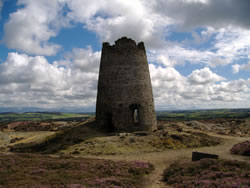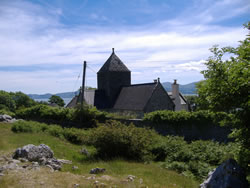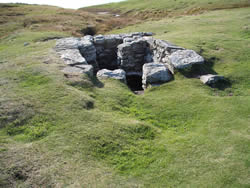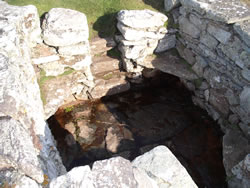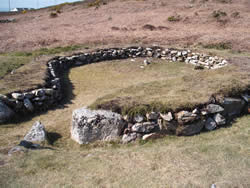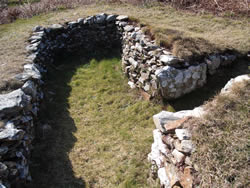Anglesey Archaeology
Information and images of Anglesey's archaeology may also be found in the Five Towns and Places menus under the Main Menu.
Aberlleiniog Castle
One of the lesser known historic sites on Anglesey, Aberlleiniog Castle lies to the east of Llangoed, on the south-eastern corner of the island. The castle dates from about 1090, and was constructed by the Normans. It predates Beaumaris Castle by some 200 years. Originally constructed of wood on a raised mound, it was later reconstructed of stone.
Barclodiad y Gawres, Cable Bay
This burial chamber is in a most impressive setting on the northern headland of Cable Bay, or Porth Trecastell. This site is recognised as one of the most important in the United Kingdom, dating as it does back some 5,000 years. The name Barclodiad y Gawres means the apron of the giantess, which is a fanciful implication of how the mound was carried to the headland. Public access is restricted and if you wish to enter the chamber, you will need to be accompanied. Details of arrangements for access are at the site. A torch is strongly recommended to be able to see the individual burial chambers, and carved stones.
Beaumaris Castle
The last castle to be built in Wales on the orders of Edward 1, Beaumaris is perfectly sited to defend the eastern approaches of the Menai Straits. It was constructed by Master James of St John, who had been responsible for the rather more imposing castles at Caernafon and Conwy, amongst others. In addition to very substantial outer and inner walls, the castle had a moat from which access could be gained to the sea. The castle was constructed between 1295 and 1297, but never entirely finished. The materials for its construction came from the nearby Penmon Quarry.
Beaumaris Castle is recognised by UNESCO as a World Heritage Site.
Bryn Celli Ddu
This is a well preserved Stone Age burial mound to the south east of Llanddaniel, dating back over 4,000 years. Bryn Celli Ddu means the Mound in the Dark Grove. The earliest monument here was a henge, or circular bank and ditch, surrounded by a stone circle. This then became a passage grave and cairn. The passage is aligned so that the rising sun shines through it on mid-summer's day. The greensward covering on the mound is a later reconstruction, and the original mound covered a greater area.
Din Lligwy
A mystical place dating from the first century AD. The outer walls are well-preserved, and surround the remains of rectangular and circular structures. Although built on raised ground, the settlement is well hidden from sight by the surrounding trees.
For details of Hen Gapel Lligwy, dating from the twelfth century, see below.
Din Lligwy Burial Chamber
Lligwy Burial Chamber, with an impressively substantial henge capstone, dates back to the late Neolithic period. The capstone measures some 18 feet by 15 feet and has been estimated to weigh 25 tons. It is supported on eight stones. Excavated in 1909, the remains of up to 30 humans were found, along with flints and remains of pots.
Hen Gapel, Lligwy
Hen Gapel, Lliwgy (Gapel is a Welsh language mutation from Capel, but means exactly the same) is a modest structure, parts of which date back to the twelfth century. Now missing its roof, the remaining structure of the chapel is well-preserved and includes a bellcote, and a small vault. The crypt or vault, the entrance to which is shown in picture 3 is a later sixteenth century addition, along with the side chapel constructed above it. What is striking about it is that there are no centres of population near to it. The structure has been described as a 'chapel of ease', meaning that it was a subsidiary to a larger church, but that larger church remains unidentified, and the history of this chapel is by no means clear.
Parys Mountain, or Mynydd Parys
The history of copper mining on Parys Mountain is now known to date back at least to the Bronze Age. At its peak, around the 1770's, the mines became the world's greatest in terms of the amount of copper extracted. The mineral was taken to Amlwch Port for export around world. The copper was also used in the shipping industry, to sheath the wooden timbers of sailing vessels. This practice prevented attack by shipworm, and gave rise to the expression of copper-bottomed guarantees. Copper cladding also gave sailing vessels a speed advantage, and it was used in war ships, including Nelson's flagship, Victory.
Penmon
Outside the village of Penmon lies Penmon Priory. The original Priory dates back to the sixth century, but the present structures are from the twelfth century. The sixteenth century prior's house is now in private ownership, and this links the Priory to the Church of Saint Seiriol, which is still in regular use. The church houses a 1,000 year old font, and two crosses, one dating from the tenth century. These crosses were originally outside but were moved into the church for protection from the elements.
From the church, a path leads to the fish pond, which was in use by the monks as part of their food supply, and ends at St Seiriol's Well. The foundations of this date back to the sixth century, but the brick shelter is a Victorian addition.
Across the road from the Priory is Penmon Dovecote which could house up to 1,000 pigeons. The Dovecote ensured a supply of meat and eggs to the nearby Bulkley Estates.
St Gwenfaen's Well, Rhoscolyn
Gwenfaen was a sixth century saint. The well is close to the abandoned coastguard lookout on Rhoscolyn Head, and its water was said to be noted for its ability to curing mental disorders. The parish church in the village of Rhoscolyn is dedicated to St Gwenfaen.
Ty Mawr Hut Group, Holyhead Mountain
This is located on the road to South Stack. It comprises a number of low circular stone walls, which are the remains of up to ten houses or small farmsteads dating back at least 2,500 years. The site was originally far more expansive, as over fifty buildings were recorded here in the 1860's, spread over an area of some 15-20 acres (6-8 hectares).


